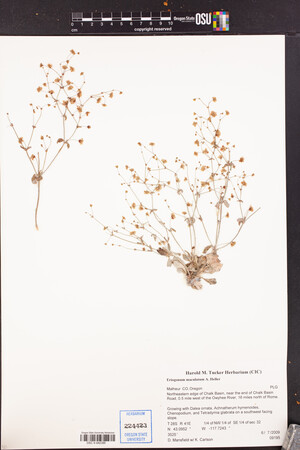Eriogonum maculatum
|
|
|
|
Family: Polygonaceae
spotted buckwheat, more...Spotted Wild Buckwheat, skeleton weed
[Eriogonum angulosum subsp. maculatum (Heller) S. Stokes, moreEriogonum angulosum var. maculatum (Heller) Jepson, Eriogonum angulosum var. rectipes , Eriogonum cernuum subsp. acutangulum (Gandog.) S. Stokes] |
Herbs, erect to spreading, annual, 1-2(-3) dm, tomentose, greenish to reddish. Stems: caudex absent; aerial flowering stems erect, not striated or angled, solid, not fistulose, 0.1-0.5 dm, tomentose. Leaves basal and cauline; basal: petiole 0.3-1 cm, floccose, blade lanceolate to obovate, 1-3(-4) × 1-1.5(-2) cm, tomentose abaxially, sparsely floccose to glabrate and grayish to greenish adaxially, margins entire or infrequently crenulate; cauline sessile, blade lanceolate to oblanceolate, 0.5-2 × 0.3-1 cm, similar to basal blade. Inflorescences cymose, open, 5-25 × 10-30 cm; branches tomentose; bracts 3, scalelike, 0.5-2.5 × 1-2 mm. Peduncles spreading, straight or nearly so, filiform, (0.5-)1-3 cm, glandular-puberulent. Involucres campanulate, 1-1.5(-2) × 1.5-3(-3.5) mm, glandular-puberulent; teeth 5, erect, 0.4-0.8 mm. Flowers 1-2.5 mm; perianth white to yellow, becoming pink or red, with a conspicuous rose-purple spot on each outer tepal, glandular-puberulent; tepals dimorphic, those of outer whorl elliptic to roundish or obovate, inflated from base to middle, those of inner whorl lanceolate; stamens included, 1-1.5(-2) mm; filaments pilose proximally. Achenes brown, 3-gonous, 1-1.5 mm, glabrous. 2n = 40. Flowering Apr-Nov. Sandy to gravelly or clayey flats and slopes, mixed grassland, saltbush, creosote bush, and sagebrush communities, pinyon-juniper and montane conifer woodlands; 100-2500 m; Ariz., Calif., Idaho, Nev., N.Mex., Oreg., Utah, Wash.; Mexico (Baja California). Eriogonum maculatum is the most common and widespread expression of the E. angulosum complex, being found in Arizona, California, southwestern Idaho, Nevada, northwestern New Mexico, eastern Oregon, western Utah, and southeastern Washington. It is often common to abundant and may even be weedy, especially along roadsides intermixed with other annual wild buckwheats. The swollen bases of the outer tepals readily distinguish the species. The greatest concentrations of the spotted wild buckwheat are found in the Mojave Desert and the Great Basin. A specimen supposedly found on the 'Laramie Plains' of Wyoming (Parry s.n., 1882, ISC) is discounted as to location.
FNA 2005, Jepson 2012, Kearney and Peebles 1969 Duration: Annual Nativity: Native Lifeform: Forb/Herb General: Herbaceous annuals, to 30 cm tall, stems erect to spreading, with aerial flowering stems erect, not striated or angled, herbage greenish or reddish with tomentose, glabrous, or occasionally glandular, caudex absent. Leaves: Alternate or whorled, linear to lanceolate or oblanceolate to obovate, 1-4 cm long and 1-2 cm wide and becoming reduced distally, tomentose below, sparsely floccose to glabrate and grayish to greenish above, margins entire or infrequently crenulate, basal blades sheathing on the stems, positioned above the basal and beneath the other blades, cauline blades sheathing or not, ocreae absent, (ocrae are sheaths around the stems formed from the stipules), cauline blades sessile, basal blades borne on petioles to 1 cm long. Flowers: White to yellow, pink or red, with a rose-purple spot, flower-like perianths 1-2.5 mm long, with glandular-hairy surfaces, the outer lobes elliptic to rounded and inflated from the base to the middle, inner lobes lanceolate, inflorescences in open cymes 5-25 cm high and 10-30 cm wide, the branches tomentose with spreading peduncles and 0.5-3 cm long, more or less straight and thread-like with glandular-hairy surfaces, also with 3 scalelike bracts 3 0.5-2.5 mm long and 1-2 mm wide, as well as subtending involucres 1-2 mm long, 1.5-3.5 mm wide and glandular-hairy. Fruits: Achenes, oboconic and brown or black with 3 edges, 1-1.5 mm long with glabrous surfaces. Ecology: Found on sandy or gravelly surfaces or on clayey flats and slopes, in mixed grassland, saltbush, creosote bush, and sagebrush communities, pinyon-juniper and montane conifer woodlands, from 350-8,500 ft (106-2591 m); flowering April-November. Distribution: Arizona, California, Idaho, Montana, New Mexico, Nevada, Oregon, Washington, Utah; Mexico. Notes: This small eriogonum often has pale yellow or creamy white flowers and white floccose or white tomentose surfaces on the undersides of the leaves, along with the segmented outer surfaces of the perianth and white-lantate involucre margins. The young plants often have purple or red-tipped buds. Look for it in Arizona in Graham, Yavapai, Mohave, Gila, Pinal, Maricopa, and Pima counties. Ethnobotany: Unknown, but other species in the genus have uses. Synonyms: Eriogonum angulosum subsp. maculatum, E. angulosum var. maculatum, E. angulosum var. rectipes Editor: LCrumbacher2012 Etymology: Eriogonum comes from the Greek erion, "wool," and gonu, "joint or knee," in reference to the hairy or woolly joints of some of the species of the genus, and maculatum means spotted, referring to purple splotches on the stems of leaves or on petals. |


































































































